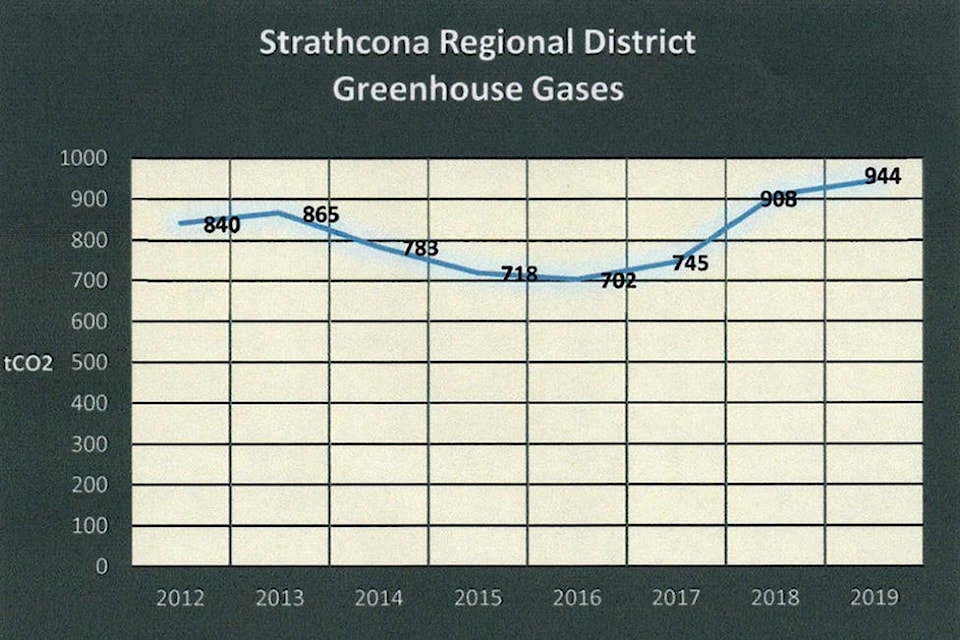Greenhouse gas emissions rose in the Strathcona Regional District in 2019 to the highest point since it signed the B.C. Climate Action Charter in 2012.
“If you’re a signatory, you have agreed to working towards becoming carbon neutral, measuring and reporting on community greenhouse gas emissions and creating complete, compact and more efficient rural and urban communities,” explained Edith Watson, senior executive assistant at the regional district.
At its May 27 meeting, the SRD board was presented with a report on its progress towards the charter’s goals. The report also functioned as a way to fulfill the regional district’s requirement to fulfill the Climate Action Revenue Incentive Program (CARIP) grant, which it uses to cover the cost of paying carbon taxes. The charter commits local governments in B.C. to achieving certain climate goals, including achieving carbon neutrality within the corporate structure by 2012, measuring and reporting on greenhouse gas emissions within the community and working to create energy-efficient communities. Meeting one of these three goals qualifies districts for the grant. In 2019, the SRD did measure and report their greenhouse gas emissions at the corporate level, and therefore met the criteria for the grant.
In 2019, the SRD’s corporate emissions were 944.38 tonnes of co2 (tCO2), according to the report. That number is the highest it has been since the regional district signed the charter in 2012 (804 tCO2). The report lists increased travel by directors and staff as well as an increase in natural gas consumption as reasons for the increase. A further reason for a sharp uptick that started in 2018 was the new requirement to report the emissions of contracted services.
”The regional district is growing as far as the level of services that we’re providing,” Watson said. “That in itself has some contributions to the increases.”
Under the charter, governments can take action to reduce their carbon emissions through three options. The first is to invest in a Green Communities Committee-supported project in the community, which includes things like energy efficiency retrofits, solar thermal systems, and low-emission vehicles. The second option is to invest in a similar project that is not supported by the Green Communities Committee. A third option is to purchase carbon offsets.
“Offsets vary in price, but I think the average is about $35 a tonne,” Watson said. “To purchase them for the 2019 year, the estimated cost was somewhere around $33,000.”
Though $33,000 may seem like a large number, it is only a small portion of the regional district’s annual budget. According to the regional district’s financial plan for example, the amount budgeted for 2020 for printer and copier replacement was $30,000. Financial planning for a regional district is nuanced and complicated, and diverting funds is often not possible.
According to the report, the district did not purchase any carbon offsetting, nor did it invest in environmentally-friendly projects that are listed by the committee or otherwise. The staff report said in multiple places that under the charter there is no legal obligation to purchase offsets.
As there is no board-adopted sustainability plan in place at the regional district, staff seek opportunities wherever possible to reduce the environmental footprint. The majority of the district’s emissions come from the directors’ travel and fuel consumption as well as natural gas consumption at Strathcona Gardens. In recent years, programming at the facility has been full, and the ice has been kept on the rinks longer into the spring to meet demand. A planned renovation of the facility includes some more energy-efficient systems.
“Our emissions are calculated on our fuel, so gasoline for the vehicles and the directors travel,” Watson said. “When they purchase gasoline when they travel, those amounts contribute to the emissions. Those are a little hard to reduce at this point, unless they went to electric vehicles. Those present challenges as well, knowing that the regional district goes out to Kayuquot and places that are just not feasible for electric vehicles to get to.”
“We could look at reducing natural gas consumption, however, that all takes money,” she added. “That is all Strathcona Gardens related. We don’t use it here at the corporate office.”
The regional district uses their annual CARIP grant to cover their carbon taxes and puts that money back into the departments to help find ways to reduce emissions.
“For 2019, our claim is just over $30,000, which then will be put back into the services that created those emissions to hopefully look for reductions,” Watson said. “It could go toward the offsets, that’s totally up to the board.”
RELATED: Campbell River Community Centre gets new high-speed vehicle charging station
DAVE’S DIGS: Politicians must answer young people’s calls for climate action
marc.kitteringham@campbellrivermirror.com
Like us on Facebook and follow us on Twitter
